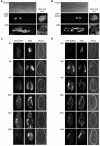The SUMO pathway is developmentally regulated and required for programmed DNA elimination in Paramecium tetraurelia
- PMID: 16682458
- PMCID: PMC1459683
- DOI: 10.1128/EC.5.5.806-815.2006
The SUMO pathway is developmentally regulated and required for programmed DNA elimination in Paramecium tetraurelia
Abstract
Extensive genome-wide remodeling occurs during the formation of the somatic macronuclei from the germ line micronuclei in ciliated protozoa. This process is limited to sexual reproduction and includes DNA amplification, chromosome fragmentation, and the elimination of internal segments of DNA. Our efforts to define the pathways regulating these events revealed a gene encoding a homologue of ubiquitin activating enzyme 2 (UBA2) that is upregulated at the onset of macronuclear development in Paramecium tetraurelia. Uba2 enzymes are known to activate the protein called small ubiquitin-related modifier (SUMO) that is covalently attached to target proteins. Consistent with this relationship, Northern analysis showed increased abundance of SUMO transcripts during sexual reproduction in Paramecium. RNA interference (RNAi) against UBA2 or SUMO during vegetative growth had little effect on cell survival or fission rates. In contrast, RNAi of mating cells resulted in failure to form a functional macronucleus. Despite normal amplification of the genome, excision of internal eliminated sequences was completely blocked. Additional experiments showed that the homologous UBA2 and SUMO genes in Tetrahymena thermophila are also upregulated during conjugation. These results provide evidence for the developmental regulation of the SUMO pathway in ciliates and suggest a key role for the pathway in controlling genome remodeling.
Figures






Similar articles
-
SUMOylation is developmentally regulated and required for cell pairing during conjugation in Tetrahymena thermophila.Eukaryot Cell. 2015 Feb;14(2):170-81. doi: 10.1128/EC.00252-14. Epub 2014 Dec 19. Eukaryot Cell. 2015. PMID: 25527524 Free PMC article.
-
The conjugation-specific Die5 protein is required for development of the somatic nucleus in both Paramecium and Tetrahymena.Eukaryot Cell. 2010 Jul;9(7):1087-99. doi: 10.1128/EC.00379-09. Epub 2010 May 21. Eukaryot Cell. 2010. PMID: 20495055 Free PMC article.
-
Non-Mendelian inheritance and homology-dependent effects in ciliates.Adv Genet. 2002;46:305-37. doi: 10.1016/s0065-2660(02)46011-7. Adv Genet. 2002. PMID: 11931229 Review.
-
Functional study of genes essential for autogamy and nuclear reorganization in Paramecium.Eukaryot Cell. 2011 Mar;10(3):363-72. doi: 10.1128/EC.00258-10. Epub 2011 Jan 21. Eukaryot Cell. 2011. PMID: 21257794 Free PMC article.
-
Transposon domestication versus mutualism in ciliate genome rearrangements.PLoS Genet. 2013;9(8):e1003659. doi: 10.1371/journal.pgen.1003659. Epub 2013 Aug 1. PLoS Genet. 2013. PMID: 23935529 Free PMC article. Review.
Cited by
-
Highly precise and developmentally programmed genome assembly in Paramecium requires ligase IV-dependent end joining.PLoS Genet. 2011 Apr;7(4):e1002049. doi: 10.1371/journal.pgen.1002049. Epub 2011 Apr 14. PLoS Genet. 2011. PMID: 21533177 Free PMC article.
-
Depletion of UBC9 Causes Nuclear Defects during the Vegetative and Sexual Life Cycles in Tetrahymena thermophila.Eukaryot Cell. 2015 Dec;14(12):1240-52. doi: 10.1128/EC.00115-15. Epub 2015 Oct 9. Eukaryot Cell. 2015. PMID: 26453653 Free PMC article.
-
A SUMO E3 ligase promotes long non-coding RNA transcription to regulate small RNA-directed DNA elimination.Elife. 2024 Jan 10;13:e95337. doi: 10.7554/eLife.95337. Elife. 2024. PMID: 38197489 Free PMC article.
-
Pdsg1 and Pdsg2, novel proteins involved in developmental genome remodelling in Paramecium.PLoS One. 2014 Nov 14;9(11):e112899. doi: 10.1371/journal.pone.0112899. eCollection 2014. PLoS One. 2014. PMID: 25397898 Free PMC article.
-
SUMOylation is developmentally regulated and required for cell pairing during conjugation in Tetrahymena thermophila.Eukaryot Cell. 2015 Feb;14(2):170-81. doi: 10.1128/EC.00252-14. Epub 2014 Dec 19. Eukaryot Cell. 2015. PMID: 25527524 Free PMC article.
References
-
- Bétermier, M. 2004. Large-scale genome remodelling by the developmentally programmed elimination of germ line sequences in the ciliate Paramecium. Res. Microbiol. 155:399-408. - PubMed
-
- Coyne, R. S., M. A. Nikiforov, J. F. Smothers, C. D. Allis, and M. C. Yao. 1999. Parental expression of the chromodomain protein Pdd1p is required for completion of programmed DNA elimination and nuclear differentiation. Mol. Cell 4:865-872. - PubMed
-
- Dryl, S. 1959. Antigenic transformation in Paramecium aurelia after homologous antiserum treatment during autogamy and conjugation. J. Protozool. 6:25.
Publication types
MeSH terms
Substances
LinkOut - more resources
Full Text Sources

